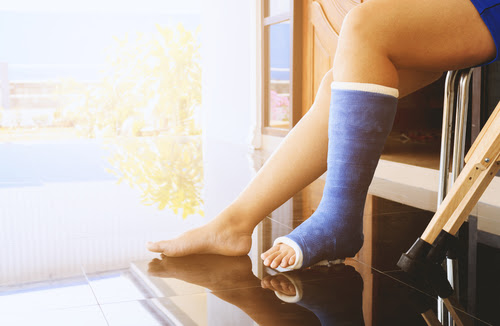Your Leg Was in a Cast. Still Painful, Weak, or Unsteady?
Over 2 million legs are fractured each year in the U.S.
The three most common types of leg fractures are:
- Patella (knee cap)
- Tibia/Fibula (lower leg)
- Ankle
The most common cause of fractures is falling, or being hit, such as in sports injuries.
Foot injuries and fractures can result in a cast also.
You broke your foot or leg. Months later, it still feels unsteady, hurts or is weak. What else might be going on?
There are so many ways you might have ended up with a cast on your leg, usually from broken bones in your foot, ankle, lower leg, or upper leg.
Often your foot and leg are immobilized in the cast for 5-6 weeks. Once the cast comes off you expect to return to normal over the course of several weeks. Adults are often prescribed physical therapy, even though children would benefit too. You do the exercises, yet things just don’t feel right.
We meet so many people who have had a broken leg or foot! Sometimes the fracture was years ago, but still causes issues for you.
3 common issues once the cast comes off
These are the most common lingering issues that we find post-foot or leg fracture:
- Feeling unsteady
- Lack of strength
- Pain at the ankle, knee, or low back
If you’ve had any of these, you’ve likely tried physical therapy or chiropractic treatment, but with limited results. Time to try another approach.
The key to finding the complete solution for feeling ‘right’ again is understanding how the immobilization of the cast turned off your muscle coordination, as well as identifying underlying compensations from the original injury.
Assessing these layers of functional impact is fundamental within the Bridging® process and is what we use to quickly get you moving better!
What really happens when your foot and leg have been in a cast?
A cast on your foot and leg means the muscle coordination is shut down for many weeks. The biggest impact is the loss of the neuromuscular coordination between the ankle and knee. And of course, there are the compensations created in your hips, the other leg, and low back.
There is so much more at rebuild than simply being able to bend and straighten again!
Unsteady or weak due to lost transitions between the ankle and knee
The foot and ankle should act like a shock-absorber and adapt as we traverse different surfaces. This multi-dimensional movement from the foot should activate muscles around the knee to dynamically provide balance control.
In addition, the strength of your leg comes from the ability of the foot and lower leg to fire the muscles of the thigh and core. These are your power muscles! A cast will often interrupt the flow which triggers all of these muscles, leaving you wondering why you can’t rebuild your strength.
This foot-knee-thigh-core muscle coordination took years to form when you were an infant and toddler, and it enables so much more than just bending. By referencing these early movement transitions, Bridging® is uniquely able to restore this dynamic control and strength.
Lower back stiffness or pain
There are usually two reasons for lower back discomfort after your leg has been immobilized in a cast – compensations and the original injury event.
The easiest to understand is the compensation of moving around awkwardly for many days. By swinging the cast leg around oddly, or walking unevenly between cast and shoe foot, it throws off the movement of the pelvis and stresses your lower back.
The second reason is a direct result of what else happened when you broke the bones. Was there a fall with a weird landing that knocked everything off center? Was there a compression of the leg into the core from landing too hard?
The Bridging® process looks at the way you were compensating and the way you were impacted by the event causing injury. By doing this we are able to find the fastest way to reset the transitions your legs and core go through to relieve your lower back.
Smooth gait and agility
The finishing touch in getting you back to normal is often matching up how the right and left legs are moving and transitioning. In the Bridging® process, it is the last step we go through. We use little wiggling movements to match up the right and left side movement of your core, and of each leg and foot. You test it out and we refine based upon what we see and what you feel.
For a quick start to the process on your own, check out this video. It may be just enough to help you feel better!
More to your full recovery …
At The Bridging® Institute our clients are often surprised by how fast they improve. Uniquely, our approach goes back to early development as the secret.
Recreating early layers of muscle and joint interconnections is the roadmap for sustainably resetting your (or your child’s) body after accidents, illness, or growth. Bridging® rebuilds the original movement foundation; your daily activity reinforces the better function.
Wondering if Bridging® can help you or your child feel and function better after a broken bone? Fill out our intake form and we’ll get back to you with insights on how Bridging® can help. Virtual or in-office sessions are two options we offer to get you back to feeling your best.

